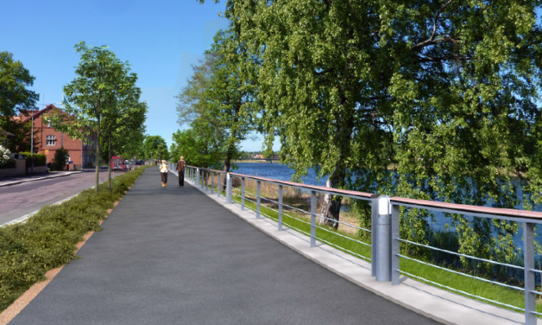The Central Hospital for Värmland is located next to the Klarälven River in Karlstad and vital functions will be flooded if the river rises more than 2.3 metres. Such a flood is estimated to occur once every 100 years on average. The consequences entail major risks to patient safety and the hospital would probably also need to be evacuated. In addition to the flood risk from the river, the area is also sensitive to precipitation.
Flood bank with walkway and bicycle path
The County Council that is responsible for the hospital investigated how the hospital could best be protected at the same time that the municipality began planning a walkway and bicycle path along the river. Since a flood bank would also have to be drawn along the river, the idea was born to have a combined solution.
The decision was to build a flood bank of just over one kilometre with a walkway and bicycle path that will protect the 23.5 hectare large hospital area. A part of the project is technically improving the storm water run-off system at the same time and reinforcing it with open solutions. The walkway and bicycle path will also improve road safety for unprotected road users and increase accessibility. The start of construction was originally planned for winter 2014/2015, but was delayed and instead began in 2016. In September 2017, the northern parts of the flood bank, the sheet piling and the walkway and bicycle path were finished and the work is continuing to the south. The project is scheduled for completion in 2019.
Early in the project, prospective illustrations were made of the finished results that simplified communication in consultations with nearby residents. The nearby residents had a positive reaction to the project and wondered if it would be possible to extend the flood bank further and protect a larger area.

The objective is to achieve a safe Central Hospital that can work even in the worst conceivable flood scenarios. A positive effect of the permanent flood bank is also that the rescue service need not set aside resources to protect the hospital in a flood situation in Karlstad. This means that they can concentrate on protecting the rest of the city and the municipality.
Financing
The project is estimated to cost around SEK 58 million in total of which the municipality will pay around SEK 20 million and the County Council will pay SEK 38 million. The County Council is paying for the sheet piling, pumping stations and water and sewage solutions on its land, and the municipality is paying for the road and street and water and sewage improvements on its land. For the costs that can be linked to protection against the river, an application has been sent to the Swedish Civil Contingencies Agency (MSB). Grants for studies and the permit application were approved in 2016, but a response to the application for a grant for the construction had not been received in autumn 2017.
More examples of climate adaptation
This is one of many examples of climate adaptation. There are more in the collection of ideas being built up by the Swedish National Knowledge Centre for Climate Change Adaptation at the Swedish Meteorological and Hydrological Institute (SMHI). The collection of examples has the aim of sharing experiences and providing ideas to everyone who works with climate adaptation. Examples describe concrete measures and challenges in several subject areas. They show how different actors have worked to adapt their activities to the climate changes that are already being noticed today and those that we cannot prevent in the future.